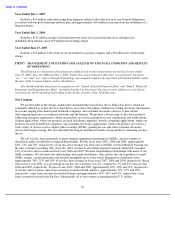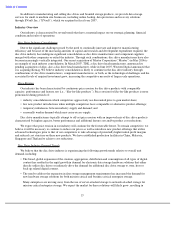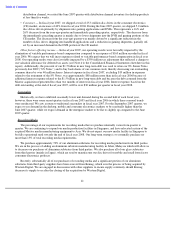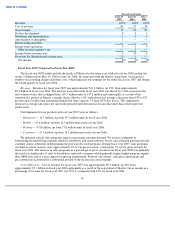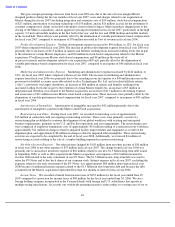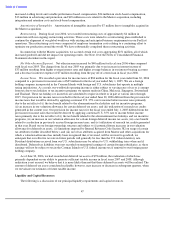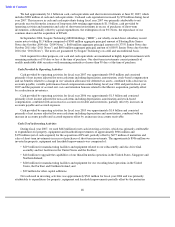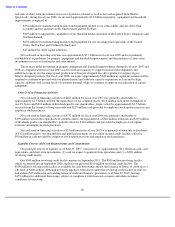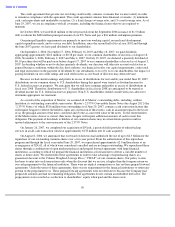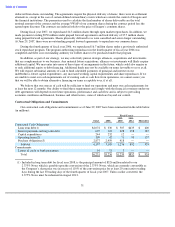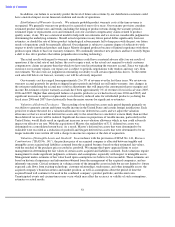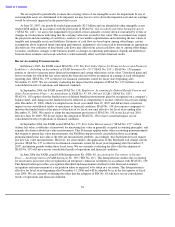Seagate 2006 Annual Report Download - page 48
Download and view the complete annual report
Please find page 48 of the 2006 Seagate annual report below. You can navigate through the pages in the report by either clicking on the pages listed below, or by using the keyword search tool below to find specific information within the annual report.
Table of Contents
is exempt from tax due to tax holidays or tax incentive programs we operate under in China, Malaysia, Singapore,
Switzerland and Thailand. These tax holidays or incentives are scheduled to expire in whole or in part at various
dates through 2020. Our provision for income taxes recorded for the fiscal year ended June 29, 2007 differs from the
provision for income taxes that would be derived by applying a notional U.S. 35% rate to income before income
taxes primarily due to the net effect of (i) a decrease in our valuation allowance for certain deferred tax assets and
(ii) the tax benefit related to the aforementioned tax holidays and tax incentive programs. Our provision for income
taxes recorded for the fiscal year ended June 30, 2006 differed from the provision for income taxes that would be
derived by applying a notional U.S. 35% rate to income before income taxes primarily due to the net effect of (i) the
tax benefit related to the aforementioned tax holidays and tax incentive programs, (ii) an increase in our valuation
allowance for certain deferred tax assets, and (iii) utilization of research tax credits generated in the current year.
Based on our foreign ownership structure and subject to (i) potential future increases in our valuation allowance
for deferred tax assets and (ii) limitations imposed by Internal Revenue Code Section 382 (“IRC Section 382”) on
usage of certain tax attributes (further described below), we anticipate that our effective tax rate in future periods will
generally be less than the U.S. federal statutory rate. Dividend distributions received from our U.S. subsidiaries may
be subject to U.S. withholding taxes when and if distributed. Deferred tax liabilities have not been recorded on
unremitted earnings of certain foreign subsidiaries, as these earnings will not be subject to tax in the Cayman Islands
or U.S. federal income tax if remitted to our foreign parent holding company.
During fiscal year ended June 29, 2007, we reduced our valuation allowance recorded in prior years for our
deferred tax assets by $641 million. This release of valuation allowance was largely due to the completion during
fiscal 2007 of the restructuring of our intercompany arrangements, which enabled us to forecast our U.S. profits with
greater certainty and the recording of a U.S. taxable gain in connection with the intercompany sale of certain Maxtor
intangible assets as described below. As a result of the valuation allowance release, we recorded a U.S. deferred tax
benefit of $319 million and a $322 million reduction in the goodwill originally recorded in connection with the
Maxtor acquisition. The reduction in goodwill was required in accordance with Financial Accounting Standards
Board (“FASB”) Statement (“SFAS”) No. 109, Accounting for Income Taxes (“SFAS No. 109”) as a result of the
reversal of valuation allowance that had been previously recorded as of the date of acquisition against Maxtor related
deferred tax assets primarily for tax net operating loss carryovers. The valuation allowance was reduced primarily to
reflect the realization of acquired Maxtor net operating loss carryforwards due to increased forecasts of future
U.S. taxable income and a $296 million gain for U.S. tax purposes from the intercompany sale of certain intellectual
property rights to a foreign subsidiary. Approximately $120 million of tax expense associated with the gain on the
intercompany sale of intangibles has been capitalized in accordance with Accounting Research Bulletin No. 51,
Consolidated Financial Statements (“ARB No. 51”) and is being amortized to income tax expense over a sixty-
month period, which approximates the expected useful life of the intangibles sold in the intercompany transaction.
As of June 29, 2007, we recorded net deferred tax assets of $768 million, the realization of $663 million of
which is primarily dependent on our ability to generate sufficient taxable income in future periods. Although
realization is not assured, we believe that it is more likely than not that these deferred tax assets will be realized. The
amount of deferred tax assets considered realizable, however, may increase or decrease in subsequent quarters, when
we reevaluate our estimates of future taxable income.
As a result of the Maxtor acquisition, Maxtor underwent a change in ownership within the meaning of IRC
Section 382 on May 19, 2006. In general, IRC Section 382 places annual limitations on the use of certain tax
attributes such as net operating losses and tax credit carryovers in existence at the ownership change date. As of
June 29, 2007, $1.4 billion and $337 million of U.S. federal and state net operating losses, respectively, and
$47 million of tax credit carryovers acquired from Maxtor are generally subject to an annual limitation of
approximately $110 million. Certain amounts may be accelerated into the first five years following the acquisition
pursuant to IRC Section 382 and published notices.
On January 3, 2005, we underwent a change in ownership under IRC Section 382 due to the sale of common
shares to the public by our then largest shareholder, New SAC. Based on an independent valuation as of January 3,
2005, the annual limitation for this change is $44.8 million. As of June 29, 2007, there were $447 million of U.S. net
operating loss carryforwards and $111 million of U.S. tax credit carryforwards subject to IRC Section 382
45



